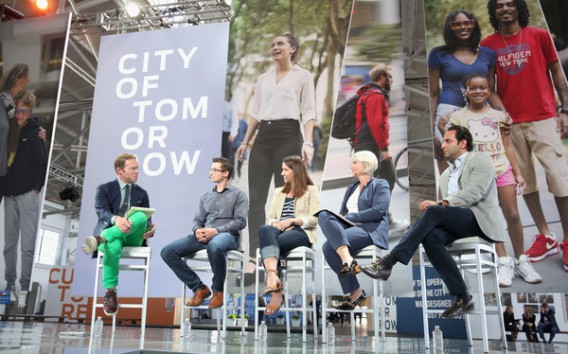















October 08, 2017 | permalink
As the leaves begin to turn, I’m finally taking a break from a frenetic summer and early fall of speaking. After wrapping up the spring with trips to Bangkok and Zurich (where I met the team behind the phenomenal Projket Interim) I’ve stuck closer to home – or at least to North America. A few highlights:
• Most recently, I was in Chicago for the Big Ideas Summit hosted by Procurious, a British social network for procurement professional (the people who run the world’s supply chains). My talk – the very short version of which is posted above – focused on “engineering serendipity,” and both unknown knowns and unknown unknowns. (I gave a similar talk earlier in the month to the Investment Industry Regulatory Organization of Canada in forest fire-choked British Columbia.)
• The week before that I was in Denver, then Victoria (British Columbia) speaking about the future of cities. In the case of the former, I was the opening keynote for this year’s RE/MAX Commercial Symposium, where I used Amazon’s HQ2 RFP as a prism to examine how cities and CRE prefernaces are changing. The next day in Victoria, I spoke at the inaugural Platform retreat hosted by the American Society of Interior Designers about how new mobility options, shared workspaces, and networks are transforming cities.

• In August, I moderated back-to-back events in San Francisco for Intel and Ford, both focused on the future of mobility. The former hosted an intimate press event to discuss its “Passenger Economy” report on the $7 trillion economic impact from autonomous vehicles by 2050, while Ford invited more than a thousand people to Fort Mason for its “City of Tomorrow Symposium.” As seen above, I was invited to moderate a panel on mobility-as-a-service, and how we go about actually building such a system. (Also on the mobility beat: in September I spoke the Columbus Partnership as part of their efforts to implement the Smart Columbus plan, which won the Department of Transportation’s Smart City Challenge.)
• But the highlight of the summer were back-to-back appearances in Colorado Springs and Albuquerque in late August. The first was for a brief talk to the senior leadership of Deloitte’s Technology, Media, and Telecommunications practice on how we might rethink the idea of what a “smart city” is. For example, rather than through solar panels and a Tesla Powerwall into your suburban home, what if we could convince institutional investors to build thousands upon thousands of Alejandro Aravena’s “half-built” homes in exchange for a 50-year on the solar electricity collected from their rooftops?
From there, I drove to Sandia National Laboratories in New Mexico for an unclassified, but off-the-record workshop on the world in 2035. I can’t divulge many details until the final report is published, but it was exhilarating to spend the day in the presence of so many brilliant people trying to invent the future. More soon, I hope.
• The rest of the fall is a bit quiet, with one great exception. Next month, I head to Los Angeles for the inaugural edition of LA CoMotion – a five-day festival of new mobility in the Arts District downtown. As director of strategy, my job is make sure the whole is greater than the sum of its many very cool parts. With only five weeks to go until Nov. 15-19, we’re in the home stretch. You can get a taste of what I’m thinking in the video below. See you on the other side.

» Folllow me on Twitter.
» Email me.
» See upcoming events.

Greg Lindsay is a generalist, urbanist, futurist, and speaker. He is a non-resident senior fellow of the Arizona State University Threatcasting Lab, a non-resident senior fellow of MIT’s Future Urban Collectives Lab, and a non-resident senior fellow of the Atlantic Council’s Scowcroft Strategy Initiative. He was the founding chief communications officer of Climate Alpha and remains a senior advisor. Previously, he was an urban tech fellow at Cornell Tech’s Jacobs Institute, where he explored the implications of AI and augmented reality at urban scale.

January 31, 2024
Unfrozen: Domo Arigatou, “Mike 2.0”
January 22, 2024
The Future of Generative AI in Architecture, Engineering, and Construction
January 18, 2024
The Promise and Perils of the Augmented City
January 13, 2024
Henley & Partners: Generative AI, Human Labor, and Mobility

----- | January 22, 2024
The Future of Generative AI in Architecture, Engineering, and Construction
----- | January 1, 2024
----- | August 3, 2023
CityLab | June 12, 2023
Augmented Reality Is Coming for Cities
CityLab | April 25, 2023
The Line Is Blurring Between Remote Workers and Tourists
CityLab | December 7, 2021
The Dark Side of 15-Minute Grocery Delivery
Fast Company | June 2021
Why the Great Lakes need to be the center of our climate strategy
Fast Company | March 2020
How to design a smart city that’s built on empowerment–not corporate surveillance
URBAN-X | December 2019
CityLab | December 10, 2018
The State of Play: Connected Mobility in San Francisco, Boston, and Detroit
Harvard Business Review | September 24, 2018
Why Companies Are Creating Their Own Coworking Spaces
CityLab | July 2018
The State of Play: Connected Mobility + U.S. Cities
Medium | May 1, 2017
Fast Company | January 19, 2017
The Collaboration Software That’s Rejuvenating The Young Global Leaders Of Davos
The Guardian | January 13, 2017
What If Uber Kills Public Transport Instead of Cars
Backchannel | January 4, 2017
The Office of the Future Is… an Office
New Cities Foundation | October 2016
Now Arriving: A Connected Mobility Roadmap for Public Transport
Inc. | October 2016
Why Every Business Should Start in a Co-Working Space
Popular Mechanics | May 11, 2016
Can the World’s Worst Traffic Problem Be Solved?
The New Republic | January/February 2016